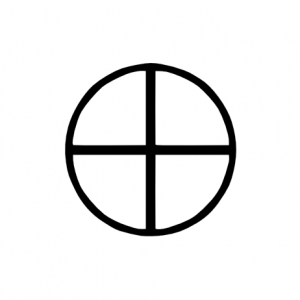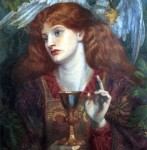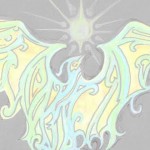One of the most common reactions when we find our way into Paganism is that we have ‘come home’. We may have never participated in a Pagan rite before, but the first time we do it seems familiar. It is like remembering something we had forgotten, a rediscovery rather than a new experience. Why do we feel this sense of connection? It may be that we carry within us the memories of a previous incarnation, or that we are drawing on human collective memory. It may be that we have seen similar rites before, but in film or on television. But it may well be because contemporary Paganism uses ancient archetypal patterns that humans find spiritually and emotionally satisfying. They are symbols that humans have used for millennia to make sense of ourselves and of the universe around us and our place in it. The word ‘archetype’ derives from Greek arch, meaning origin, and tupos, meaning imprint. The archetypes appear in similar symbols and patterns across times, places and cultures. They are the foundations of cultural, artistic and spiritual expression and come from our earliest ancestors when spirituality, art and culture were integrated in and integral to every aspect of everyday life rather than specialized activities reserved for a chosen few.
The Circle and Four Quarters
 Many of us use the archetypal symbol of the circle and the four directions as our sacred space. Why a circle? The circle is a symbol of wholeness that has been used for millennia as a place for sacred rites. When we work with particular archetypes and symbols they have powerful effects. As we integrate the symbols into our lives, they begin to shape and to change us.
Many of us use the archetypal symbol of the circle and the four directions as our sacred space. Why a circle? The circle is a symbol of wholeness that has been used for millennia as a place for sacred rites. When we work with particular archetypes and symbols they have powerful effects. As we integrate the symbols into our lives, they begin to shape and to change us.
The spiritual journey at the heart of much of contemporary Paganism is a journey into wholeness, a journey to integrate the disparate parts of ourselves and to come to a point at the centre. As we invoke the four quarters, we call the elemental energies associated with them to our sacred space. We are calling the elements in nature and we are also calling their qualities within ourselves. The four directions and the elements that are associated with them can be seen as symbolizing four aspects of ourselves – body, emotions, mind and spirit. Each is necessary for life and in the circle each is given equal weight and respect. The message is simple but profound. The journey is to find the point of balance where all aspects of our being can live in harmony with one another and fulfill its appointed function. To be whole we invite the disparate parts of ourselves into the sacred circle, the whole that contains the many, a place where what is within can unite with that which is without.
Between the worlds
In ritual, the circle is said to exist in an ‘in-between’ space. It is ‘between the worlds’. It is poised between ‘the world of men and the realms of the Mighty Ones’, between humankind and the Gods, between the spiritual and physical. It is a space where we who are in physical incarnation can meet with non-physical beings such as Gods in safety and harmony. The circle is a place of peace where our rational consciousness and the dreams and visions that come from the unconscious can meet and fertilize and re-energize one another. This is a point of interior stillness and receptivity, but it is also the point of action where we can exercise the power within. The symbols that appear to us in dream and vision are messages from the unconscious about what is happening within. To receive dreams and visions we must be in a receptive mode and prepared to see and to listen to the unconscious. In ritual, the opposite also occurs. We are in active mode as well as in receptive mode. We are magicians as well as mediums. As magicians, we become transmitters of symbols that communicate to the deeper levels of our being what we want of them.
The Mysteries
The Paganisms of the last few millennia have had both exoteric and esoteric forms. There was exoteric religion that focused on social cohesion and esoteric religion that was about forming a personal transformatory relationship with the Gods. Many of us who are contemporary Pagans practice both. We have family seasonal celebrations that remind us of the importance of our connection with nature and with one another and of how we should behave in the outer world. We may also practice meditation, vigils, and transformatory rites that are about changing the world within, our own selves. Mystery comes from the Greek word musterion, which implies something about which we should be silent. A mystery is revealed by symbol or whispered as a secret in the dark places. We have to listen hard not only because the words are whispered, but also because the words express more than their literal meaning. The meaning is a hint rather than a revelation. It is the grit that creates the pearl.
Shaping the psyche
Creating sacred space with the circle and the four directions sends a message to the deeper psyche about how we are trying to shape it. Each time we enact the rite, we reinforce that message, which expresses how we see our inner world, but also how we see the wider universe – that it is a balance of competing energies, of ice and fire, of wind and sea, of darkness and light. Realization and illumination come at the point at the centre where the competing energies meet.
What then is the mystery of the circle? The circle is a space in which everyone can see everyone else. There is no place to hide. The secret is that it is not a place of secrets, but a place of transparency and revelation. The mysteries are very simple. They are all around us – if we have eyes to see and ears to hear. Each time we make the circle, we begin again a process of communication and revelation. In our sacred space, we find and open the door that has no key.
Read this article in French, Italian, Polish, Russian, or Spanish!
















